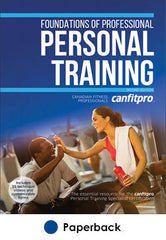Recommendations and precautions for back health
This is an excerpt from Foundations of Professional Personal Training 2nd Edition With Web Resource by canfitpro.
Even when working with clients who do not currently have lower back pain, you can help prevent its future occurrence by paying close attention to their posture, alignment, and form during each exercise and by including activities that help them strengthen the spinal stabilization system. Good posture involves a balance between flexion and extension. In this balanced position, the discs, spinal facet joints, ligaments, and muscles are under the least amount of stress. In contrast, excessive flexion puts continuous stress on the disc, leading to chronic repetitive trauma that ends in damage. Extreme extension increases the wear and tear of the facet joints.
Several activities that your clients perform daily can put their lower backs at risk. Simple behavioural changes may protect general back health during workouts and in the activities of daily life. For example, when standing, work should be kept at a proper height. Work that is too low increases disc loading, and work that is too high can strain the joints in the back. During prolonged standing, placing one foot on a bar or low stool occasionally and changing position can relieve possible strain on the back. For lifting, the low back should be in slight extension and the load should be close to the body to distribute it equally between disc and facet joint in a balanced way. Doing this may be easier with the knees slightly bent. Many health professionals believe that the combination of twisting with flexion is harmful to both facet and disc. Pivoting is preferable to twisting, and sudden jerky movements should be avoided. These guidelines are important to consider during your training sessions and in your clients' daily life. Additional recommendations for general maintenance of back health are given in table 5.4.
Learn more about Foundations of Professional Personal Training 2nd Edition With Web Resource.
More Excerpts From Foundations of Professional Personal Training 2nd Edition With Web Resource

Get the latest insights with regular newsletters, plus periodic product information and special insider offers.
JOIN NOW


